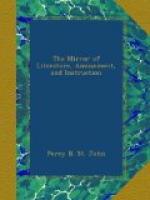OPORTO
[Illustration: Oporto.]
Persons who are looking for “news from the seat of war” will probably hail the timely appearance of this Engraving, and regard it as folks sitting at a play do a drop-scene between the acts. The reader knows our pacific politics: we are of the pen, not of the sword; but we cannot be indifferent to a great political result, when
Old men, and beldams, in the streets
Do prophesy upon it.
Oporto is a place of great commercial as well as political consideration. Thousands of Englishmen have a grateful recollection of the former importance upon their very lips. Its situation is one of great natural beauty. It is the largest city in Portugal, Lisbon excepted. It has been commonly said to owe its origin to the Romans;[1] but it appears, from the best authors, to have been founded about A.D. 417 by the Suevi, who had established themselves in Braga and other parts of ancient Galicia, but who were driven by the Alani to the banks of the Douro, where they fortified themselves on the steep hill now occupied by the cathedral and the bishop’s palace, and which is still distinguished by the appellation of the Cidade de Antiga.
[1] At Coimbra, about two
days’ journey from Oporto, is a Roman
bridge and aqueduct, nearly
entire.
The city occupies the north bank of the Douro, (anciently Durius,) about five miles from the mouth of the river, and the Atlantic Ocean. The approach from thence to Oporto is remarkably beautiful. The dangers of the bar, across the mouth of the river, once passed,[2] a succession of interesting objects present themselves on both sides, as we ascend towards the city. The little town of St. Joao da Foz stands on the north bank, close to the sea, and is the favourite resort of the wealthier inhabitants of Oporto during the violent heat of the summer. The river, immediately within the bar, expands into the appearance of a lake. A little higher up it is narrowed by two abrupt hills. That on the right terminates in a precipice of bright hard sandstone, descending so steeply to the water’s edge, that but lately a road has been made from Oporto along the bank of the river, to St. Joao da Foz, by blasting and hewing down a sufficient portion of the rock. This height, from its precipitous sides, is called the Monte d’Arabida, and forms the western boundary of a lovely valley, opening upon the Douro, covered with the Quintas, or villas, of the wealthier inhabitants of the adjoining city. Most of the Quintas at the mouth of the river command delightful prospects of the Atlantic Ocean, and the splendid effects produced on these scenes at sunset, in this glowing climate, are almost indescribable. Some idea of its beauty may be formed by reference to Colonel Batty’s view from this point.[3] The appearance of the Douro, with its numerous shipping, and the variety of interesting objects scattered on its cheerful banks, render this one of the most pleasing scenes in the circle of Oporto.




